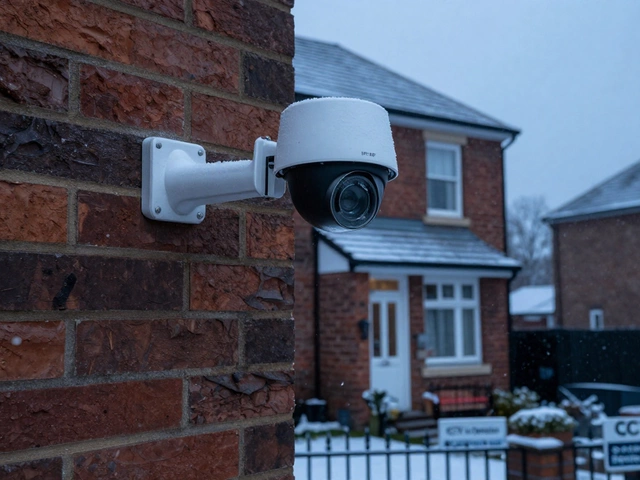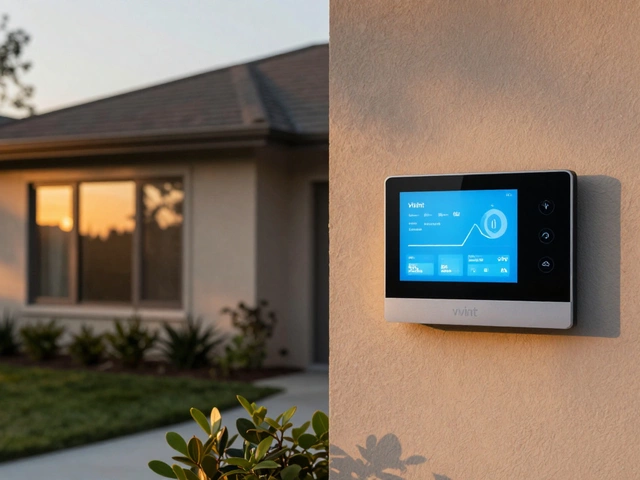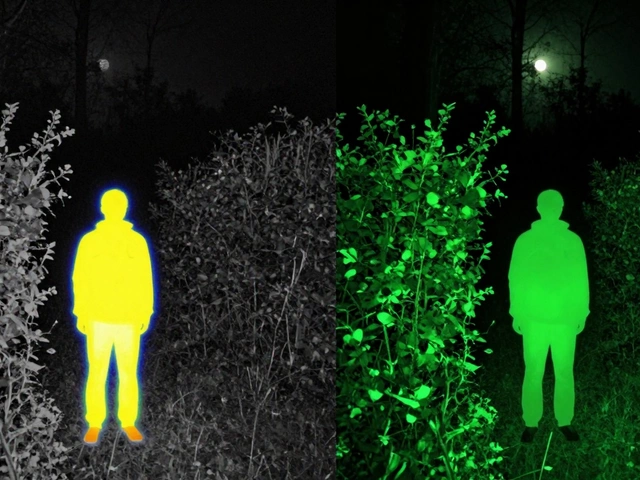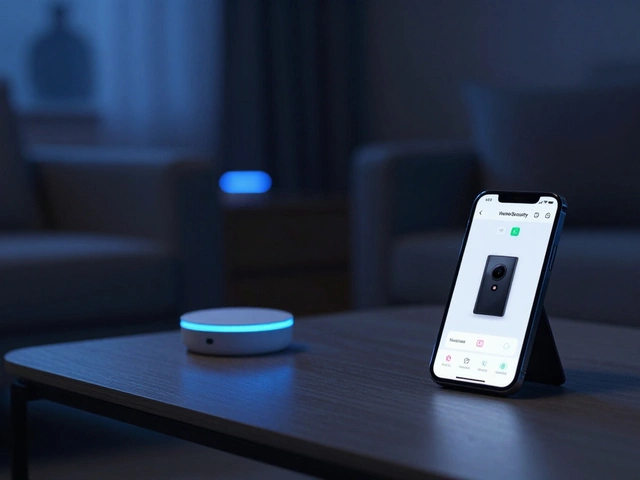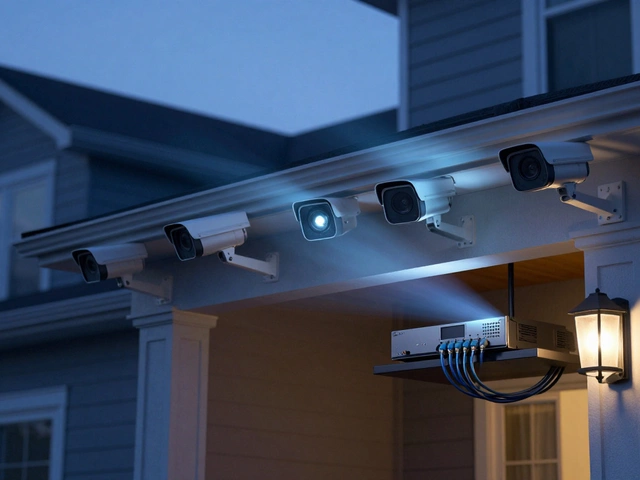Smart doorbells like Ring have become an integral part of home security systems in the UK, offering unmatched ease of monitoring activities right at your doorstep. However, as their popularity has soared, so too have concerns about privacy and surveillance.
Imagine peering outside your window only to notice a camera watching your every move. It's a discomfort many face as they try to balance their own privacy with their neighbor's security measures. Are you within your rights to block or interfere with these gadgets? This inquiry opens the door to a discussion brimming with ethical, legal, and social dimensions.
In this article, we embark on a journey navigating these wiring concerns—giving homeowners and neighbors alike a clearer perspective on what goes and what doesn't when eyeing these digital gatekeepers. Together, we’ll explore solutions to foster peaceful cohabitation in the age of smart doorbells.
- The Growing Popularity of Smart Doorbells
- Understanding Privacy Concerns
- Legal Aspects of Blocking a Ring Doorbell
- Communication with Your Neighbor
- Practical Measures and Solutions
- Tips for Co-existing with Smart Doorbells
The Growing Popularity of Smart Doorbells
The modern home has undergone a myriad of technological transformations, and among the front runners of these advancements is the smart doorbell. Ring doorbells, and their contemporaries, have seen an astronomical rise in adoption across the UK households. These devices neatly sit at the junction of innovation, offering homeowners not just a bell to signal visitors, but a window into their home’s security landscape. This intriguing mix of security and convenience has fueled their ascent into everyday life.
The allure stems from the blend of security features they offer. Equipped with high-definition cameras, two-way audio, and motion sensors, smart doorbells provide a comprehensive security solution at one's home's threshold. This functionality has proven invaluable, becoming a standard not just for tech enthusiasts but for families keen on keeping a watchful eye on their premises, whether they are in the next room or thousands of miles away. The data reveals that in the past five years alone, the sale of smart doorbells has tripled, a clear indication of their growing acceptance and reliance. Smart doorbell UK models have especially thrived due to the easy compatibility with mobile applications, making real-time monitoring a breeze.
Equipped not only with cutting-edge technology but also imbued with practical design, these devices have garnered attention for their ability to deter crime. Studies suggest that the presence of a visible camera can reduce the likelihood of a burglary by nearly 30%. It's not surprising then that insurers have jumped on board, offering premium discounts for houses employing such proactive security measures. As people become more conscious of their personal and property security, it's no wonder neighborhood networks are awash with recommendations for installing these devices.
Amidst this technological momentum, there's been an overarching narrative that these devices are more than just tools—they're transformative pieces of technology that redefine interaction with visitors and delivery personnel alike. A quote from Tech Magazine brightens this sentiment:
"Smart doorbells are not just knocking on the door of security enhancements; they are signaling a new era in how homeowners connect and protect their properties," said James Harlow, a tech industry analyst.This shift in property security means individuals who once balked at the mention of gadgets have warmed to the idea of incorporating these smart devices into their daily regime, intrigued by the dynamic and interactive experiences they present.
In an interconnected home ecosystem, smart doorbells align seamlessly with other smart devices, forming a protective barrier that is as discreet as it is efficient. They blend effortlessly with smart locks, alarms, and lighting systems to curate an integrated security grid that offers peace of mind and usability. True to their reputation, these clever door guardians champion cost-effectiveness, often functioning as an accessible entry point for consumers embarking on smart home automation journeys.
Understanding Privacy Concerns
With the rise of Ring doorbells and other smart surveillance devices, privacy has become a hot topic among UK neighborhoods. The idea of having an extra set of digital eyes watching over your property is reassuring, offering peace of mind against theft and unwanted intrusions. However, it's important to recognize that what you see as security, others might view as an invasion of privacy. The possibility of being constantly monitored, even when within the presumed privacy of one’s front yard or doorstep, can be unsettling to say the least.
This issue is significant because these devices don't just capture your property; they can inadvertently record sidewalks, streets, and a portion of your neighbor's space as well. Despite assurances from manufacturers about data security, concerns persist regarding who can access the footage and for what purposes. According to the UK Information Commissioner's Office, individuals have rights under data protection laws if the camera covers areas beyond the owner's boundary, which potentially opens up a legal can of worms.
"The law seeks to balance protection and privacy, acknowledging the importance of preserving personal space," says John Edwards, UK Information Commissioner. "It’s crucial that users carefully consider the placement of such devices to avoid unintended surveillance."
The ethical dilemma arises from this interplay between security and privacy rights. While a homeowner might install a Ring doorbell with the intention of enhancing their security, the neighbor across the fence may feel uncomfortable with the thought of every delivery or visit being recorded. This has led to an increase in disputes, where the desire for increased security clashes with the moral and sometimes legal considerations of privacy.
To understand the depth of these privacy concerns, it's essential to delve into the statistics surrounding smart doorbell usage in communities. A survey conducted by Neighbourhood Watch suggests that in 2023, only 16% of UK residents felt completely comfortable knowing they were possibly being recorded by these devices, whereas a staggering 60% expressed unease about potential privacy breaches. Maintaining a balance that satisfies both security needs and privacy concerns requires public awareness and thoughtful planning.
Privacy concerns are not merely speculative; they rest on templates of prior instances where footage intended for security was used improperly or accessed by unauthorized individuals. Reports of hacking, misuse by employees, or overly curious neighbors have surfaced over the years, adding layers of anxiety around these devices. Policymakers and tech companies work continuously to address these security loopholes, but for many, the percieved risks still weigh heavily against purported benefits.
In grappling with these issues, homeowners need to be mindful of their neighbors' rights and feelings, which can lead to effective dialogues and understanding. Sharing how these systems work, assuring coverage doesn’t infringe on others' privacy and agreeing on mutually acceptable boundaries can often alleviate concerns. This is where being a responsible tech adopter becomes as vital as the technology itself, helping to create not just safer homes, but harmonious communities.

Legal Aspects of Blocking a Ring Doorbell
In the UK, smart doorbells, especially the Ring doorbell, have ignited significant discussions regarding privacy and legality. As they quietly guard entrances, they inadvertently take on a more intrusive role, raising the question: Can you legally block your neighbor's Ring doorbell without crossing any legal lines yourself? The answer isn't straightforward. It requires a nuanced conversation around privacy law, property rights, and what constitutes reasonable surveillance. Under UK law, the Data Protection Act 2018, an extension of the EU's GDPR (General Data Protection Regulation), plays a crucial role in determining how data, including video footage, is handled.
Understanding GDPR and Your Rights
The GDPR, which set a high standard for data privacy across much of Europe, ensures that video footage that captures identifiable individuals must be processed under strict guidelines. Neighbors installing a Ring doorbell have a duty to inform visitors and passersby that they are being recorded. They must justify their surveillance activities under the legal concept known as 'legitimate interest'. This means that while a doorbell can film a person's property for security, it's legally contentious for it to record beyond those boundaries, such as public streets or a neighbor's private garden.
The Information Commissioner’s Office (ICO) states that 'if your video system captures images outside your property boundary, then the GDPR and the Data Protection Act will apply.' This quote underscores the importance of clear legal boundaries around data collection.
Taking Steps to Address Overarching Surveillance
If you suspect that your neighbor's Ring doorbell is capturing more than its fair share, the first step is to talk with your neighbor. Many cases of unwanted surveillance stem from unclear installation practices rather than malicious intent. Open communication often leads to satisfactory solutions, such as repositioning the camera or narrowing its field of view. Should discussions prove unfruitful, stronger actions might involve seeking legal advice or contacting the ICO to file a formal complaint.
- First, approach your neighbor to discuss the nature of the recordings. They might not be aware of the issue.
- Next, request modifications to the camera's angle to ensure it remains focused on their property.
- If needed, document interactions and any changes—or lack thereof—to support formal complaints.
The Balance Between Security and Privacy
It's essential to recognize that both security and privacy should coexist harmoniously. Some neighbors find reassurance in the presence of a Ring doorbell just as some might feel uneasy about them. The heart of this issue is balancing individual rights—protecting one's property versus maintaining a right to privacy. It's not just a legal debate; it's also a societal challenge. In many communities, residents have drawn up neighbor agreements to manage these concerns without involving legal authorities, through understanding and respectful dialogue.
Ultimately, while blocking a neighbor's Ring doorbell isn't legally advisable, finding a middle ground is possible—and often preferable. It encourages a neighborly atmosphere, one where technology supports, rather than hinders, community life.
Communication with Your Neighbor
One of the best ways to navigate the challenges posed by a Ring doorbell is to have an open, honest conversation with your neighbor. It's incredible how much a simple cup of tea and a chat can elevate understanding and resolve potential tensions. Communication may seem daunting at first, especially if relations are icy or if you've barely spoken since moving in. Yet, initiating a dialogue can be a profound step towards clearing the air and finding common ground. The goal isn’t to confront but to understand and be understood, fostering a neighborhood spirit instead of simmering conflicts.
Start by acknowledging the reasons they have chosen a smart doorbell, such as their desire for enhanced security. Let them know you respect their decision while expressing your concerns about privacy. It is crucial to communicate your feelings without assuming ill intent or being accusatory. This way, you're not questioning their use of technology, but indicating the impact it might have on your sense of privacy. A non-threatening approach encourages cooperation over defiance.
Building a Bridge, Not a Barrier
Emphasizing shared values can also build rapport. Everyone wants to feel secure in their home, and highlighting this shared desire strengthens the foundation for mutual understanding. You can propose exploring potential privacy solutions together. Technology has various settings and adjustments that can address concerns. For example, if their Ring doorbell captures parts of your property, suggest adjusting the camera angle or utilizing privacy zones. Many devices offer these settings, helping to focus the device on critical areas, instead of unintended places.
“The surest way to lose peace is to keep it all to yourself.” — Jospeh W. Richards
If your neighbor is tech-savvy, they might be more willing to adjust settings once mutual advantages are outlined. They might not even be aware that the device is encroaching your space, and a friendly conversation could bring this to light without causing friction. Sometimes, fear of legal consequences or complicated tech settings keeps people from discussing these issues. But clarity and open dialogues can dismantle these hindrances.
Another practical suggestion during these discussions is to share experiences from other communities. Consider mentioning statistics or anecdotes that demonstrate the benefits of balancing security with privacy. For instance, a survey by a UK-based security firm found that neighborhoods with respectful digital boundaries reported a higher sense of community safety and satisfaction. Understanding how others have amicably handled similar situations can offer relevant insights for crafting solutions tailored to your community.
Finally, it’s worth remembering that sometimes compromises might involve broader neighborhood involvement. Inviting them to a community meeting to discuss technological impacts can broaden perspectives and involve others who might have similar concerns. This collaborative approach ensures everyone's voice is heard, turning a concern into a collective opportunity for improving neighborhood harmony.

Practical Measures and Solutions
The advent of the Ring doorbell has undeniably revolutionized home security across the UK, placing residents at a unique crossroads of security and privacy. Navigating the balance between ensuring your home is safeguarded and respecting the privacy of those nearby can feel like walking a tightrope. However, various solutions can be explored to meet both security needs and privacy concerns, successfully melding technology with neighborhood harmony.
A solid first step is initiating a respectful dialogue with your neighbor. Express your concerns through an honest conversation, while shedding light on their security objectives. This openness can often diffuse tension, laying the groundwork for a collaborative solution. Through this, common ground may be found, such as angling the Ring camera in a way that bestows security benefits while minimizing the invasion into your personal space. A simple act of adjusting the focus or range of the camera can often satisfy both parties.
An often-overlooked solution involves the additional technical adjustment known as 'privacy zones', a common feature in many smart doorbell models. Educate your neighbor about configuring these zones on their device. Essentially, this setting allows users to block out areas from the camera's view, ensuring your home or garden stays outside of their recording range. This measure both resolves privacy issues and strengthens neighborly goodwill by demonstrating a willingness to work together for a peaceful coexistence.
"Privacy is not something that I'm merely entitled to, it's an absolute prerequisite." — Marlon Brando
For more tech-savvy residents, there exist physical solutions to explore, such as installing privacy screens or planting tall hedges that block unwanted surveillance. While these measures offer practical, constant coverage, they are not a false illusion for resolving disputes. Engaging with your neighbor remains paramount to maintaining a sustainable agreement for both parties.
In some cases, for those enduring persistent privacy issues, there’s the option of filing a formal complaint with local authorities or the Information Commissioner's Office. This should be considered a last resort when previous measures have fallen short. According to UK law, equipment like a Ring doorbell should not breach privacy norms, and when it does, authorities can mediate to provide appropriate resolutions ensuring the broader community's respect.
This table provides a simplified understanding of actions and outcomes when privacy concerns arise from the usage of smart doorbells in the UK:
| Action | Outcome |
|---|---|
| Have a conversation | Neighborhood understanding and collaboration |
| Adjust privacy zones | Enhanced privacy while retaining security |
| Install physical barriers | Increased privacy with minimal disruption |
| Inform authorities | Official intervention if privacy laws are breached |
Ultimately, these practical measures can cultivate a balance where technological advancement and the sanctity of privacy coexist, fostering communities where security doesn’t come at the cost of comfort. Searching for mutual solutions will likely lead to better relationships and technological utilization, reinforcing peace among neighbors.
Tips for Co-existing with Smart Doorbells
Navigating the waters of modern neighborhood living can be tricky, especially when smart technology, like a Ring doorbell, is involved. These clever gadgets, designed to enhance security, often come with challenges, especially regarding privacy. For a harmonious neighborhood, communication is key. Start by having an open conversation with your neighbor. Approach them respectfully and express any concerns you have about their smart doorbell's field of view. This creates an opportunity to reach a mutual understanding, perhaps by adjusting the camera angle or setting up privacy zones, which many devices, including the Ring, offer as options. Exploring the available settings together can lead to a better grasp of the technology and how it can serve both security and privacy needs.
Consider the role these devices play in modern security. A survey by Statista shows that 12% of UK households now use smart doorbells, a figure that's likely to grow as technology becomes more integrated into daily life. Rather than root against them, acknowledging their purpose can foster more informed and productive discussions. Recognizing that these tools aren't inherently invasive can ease tensions. Many smart doorbells, for instance, are equipped to record only when motion is detected, thus not continuously tracking activity.
If discussions don’t quite pan out, consider some practical measures. For instance, installing simple privacy screens or fences might provide the seclusion you desire without impeding anyone's home security. Alternatively, suggest using masking tape over sections of the doorbell camera's lens that capture undesired spaces without affecting their home's coverage. It is a DIY approach that often requires mere transparency and willingness to find middle ground.
Appealing to community guidance may also prove beneficial. Many local councils offer advice or mediation services for neighbors grappling with surveillance concerns. You might even discover local regulations around home surveillance which could back your requests. Ultimately, fostering a friendly neighborhood spirit can help ease the adaptation to these technological shifts. To quote Marie Curie, "Nothing in life is to be feared; it is only to be understood."
Finally, be proactive in your own home security measures. By investing in effective smart devices yourself, like window alarms or interior cameras, you'll gain peace of mind without feeling like you're relying solely on others' security measures. It’s a reminder of taking control, and being part of a cooperative community effort. This delicate balance between privacy and security can be a tricky dance, but with patience and communication, it's one that can result in everyone feeling safe and at ease in their homes.


